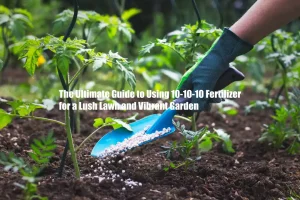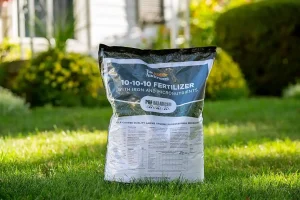
Welcome to our ultimate guide on how to use 10-10-10 fertilizer to achieve a lush lawn and vibrant garden. If you’re a gardening enthusiast or want to improve the health and beauty of your outdoor space, using the right fertilizer is essential. In this guide, read my article, and we will explore the benefits of using 10-10-10 fertilizer, how to apply it effectively, and why it is crucial for the growth and maintenance of your lawn and garden.
An overview of 10-10-10 fertilizer
Definition
Before we delve into the specifics of using 10-10-10 fertilizer, let’s understand what it is. 10-10-10 fertilizer is generally a type of granular fertilizer that contains three essential nutrients: nitrogen, phosphorus, and potassium. These nutrients, often NPK, is organic fertilizer which is vital for plant growth and development.
The numbers 10-10-10 represent the percentage of each nutrient, making up 10% of the overall content, present in the fertilizer, with nitrogen, phosphorus, and potassium being the primary components.
The importance
There are several advantages to using 10 10 10 fertilizer in your garden:
1. It provides a balanced supply of nutrients, which is critical for the health and growth of your plants.
2. The granular form of the fertilizer allows for slow release, ensuring a steady supply of nutrients over time.
3. The balanced nitrogen, phosphorus, and potassium ratio promotes healthy growth and development, leading to lush foliage and bountiful blooms.
The balanced ratio of nutrients provides plants with everything they need for optimal health and vigor. Much nitrogen stimulates leaf and stem growth, while phosphorus encourages strong root development. Additionally, potassium aids in overall plant metabolism and disease resistance. By providing these essential nutrients, 10-10-10 fertilizer helps plants reach their full potential, resulting in lush, vibrant, and healthy foliage.
Another benefit of using 10-10-10 fertilizer is its positive impact on soil fertility. The fertilizer’s nutrients replenish any soil deficiencies, ensuring that plants have access to the necessary elements for growth. This improved soil fertility leads to better nutrient absorption, more vital root systems, and increased resilience against pests and diseases. With the regular application of 10-10-10 fertilizer, the ideal period is reapplying about four times a year you can maintain healthy soil conditions and support the long-term health of your garden.
Using 10-10-10 Fertilizer for Lawns
Using 10-10-10 fertilizer is a great choice if you want to achieve a healthy lawn or shrub. But when and how should you apply it? Ideally, 10-10-10 fertilizer in early spring application when the grass starts to actively grow. This will provide the much-needed nutrients for its vigorous growth.
To ensure even distribution, you can use a fertilizer spreader. Measure the recommended dosage per square foot, the best fertilizer is not liquid fertilizer but the granular fertilizer evenly across the lawn. It also could be water-soluble fertilizer. After application fertilizer around the plants, water them thoroughly to ensure nutrients penetrate the soil and reach the grassroots.
Recommended dose of fertilizer
The recommended dosage of 10-10-10 fertilizer on your lawns is generally 1 to 1.5 pounds per 1000 square feet of lawn. However, it’s always best to refer to the specific instructions provided by the manufacturer, as the dosage may vary depending on the brand and the condition of your lawn. Applying the optimal amount of fertilizer will ensure that your lawn receives the necessary nutrients without risking over-fertilization, which can lead to nutrient runoff and environmental pollution.
Best practices for even distribution
Even distribution of 10-10-10 fertilizer is crucial for uniform nutrient uptake by the grass. To achieve this, using a fertilizer spreader is highly recommended. A spreader helps to evenly distribute the granules across the lawn, ensuring that each area receives the same amount of nutrients. When using a spreader, make sure to set it according to the recommended spreader settings for the specific fertilizer brand and application rate. Additionally, walking at a consistent pace is essential to avoid uneven application. After fertilizing, water the lawn thoroughly to help the nutrients settle into the soil.

Applying 10-10-10 Fertilizer for Gardens
Now, let’s shift our focus to using 10-10-10 fertilizer for gardens. When it comes to gardens, each plant may have its nutrient requirements. Therefore, testing to determine the right 10-10-10 fertilizer for different plants is essential. Look for a fertilizer formulated for vegetables, flowers, non-fruiting plants or other types of plants. Pay attention to the nitrogen, phosphorus, and potassium ratios in the fertilizer to ensure they match the needs of your plants.
Applying 10-10-10 fertilizer to different types of plants
When applying 10-10-10 fertilizer to different types of plants in your garden, it’s crucial to follow the recommended dosage for each plant. For example, you can apply one tablespoon of fertilizer per square foot of planting area for vegetables. For flowers, ornamental plants, or grass seeds, a general guideline is to use 1 pound of fertilizer for every 100 square feet of garden bed. Remember to water the area after applying the fertilizer to help it penetrate the soil and reach the plant roots effectively.
Precautions and tips for garden application
When applying 10-10-10 fertilizer in your garden, it’s essential to take a few precautions:
1. With foliar sprays, please avoid using the fertilizer too close to the plant stems or foliage, as it can cause leaf burn or root damage. Instead, sprinkle the granules a few inches away from the base of the plants. Also remember to wear gloves while doing things.
2. To make the fertilizers work best, always follow the recommended application rate to prevent over-fertilization, which can harm the plants.
3. For the best results, it’s advisable to prepare the garden soil test before applying the fertilizer by tilling or loosening the soil and removing any weeds or debris.
Common Issues
Over-fertilization
While using 10-10-10 fertilizer can be immensely beneficial for your lawn and garden, it’s essential to be aware of the signs of over-fertilization. One common sign is excessive vegetative growth, including lush foliage and elongated stems. This can make the plants more susceptible to disease and insect infestation.
Another sign to look out for is the yellowing or browning of leaves, which indicates nutrient imbalances. Additionally, applying much fertilizer may result in roots burning and damage to the surrounding soil. If you notice any of these signs, it’s crucial to dial back on the amount of fertilizer you’re applying and consider using a milder formulation.
Nutrient deficiencies
In addition to over-fertilization, nutrient deficiencies can also pose challenges to your lawn and garden health. 10-10-10 fertilizer can help address these deficiencies, but it’s essential to identify the specific nutrient lacking. Pale and yellowing leaves, stunted growth, and poor flowering or fruit development characterize nitrogen deficiency. Phosphorus deficiency often results in slow growth, purplish or reddish leaves, and weak root systems. Potassium deficiency can manifest as yellowing or browning of leaf margins, wilting, and increased vulnerability to disease. All-purpose fertilizer is one of the best choice. If you observe these symptoms, consider adjusting your fertilizer regimen or applying a targeted nutrient supplement to address the deficiency.
Tips for successful application
To ensure the successful application of 10-10-10 fertilizer, keep the following tips in mind. First, accurately measure the recommended dosage for your lawn or garden to avoid over-fertilization. Using a fertilizer spreader can help ensure the granules’ even distribution. The recommended type of fertilizer is synthetic fertilizer or balanced fertilizer.
Secondly, water the area thoroughly after applying the fertilizer to help the nutrients penetrate the soil and reach the roots effectively. Regularly monitoring your plants for signs of over-fertilization or nutrient deficiencies will allow you to make adjustments as necessary.
Lastly, always follow the specific instructions the manufacturer provides for optimal results, as well as making the fertilization schedule to get the best result.
Conclusion
10-10-10 fertilizer is a good formula with numerous benefits for lawns and gardens. It provides a balanced supply of essential nutrients, including nitrogen, phosphorus, and potassium, crucial for plant growth and development. The granular form of the fertilizer allows for slow release, ensuring a steady supply of nutrients over time. By promoting healthy growth and improving soil fertility, 10-10-10 fertilizer helps to create lush foliage, vibrant blooms, and bountiful harvests. Whether you apply fertilizer for your lawn or garden, this versatile fertilizer is valuable in achieving a lush and vibrant outdoor space.
